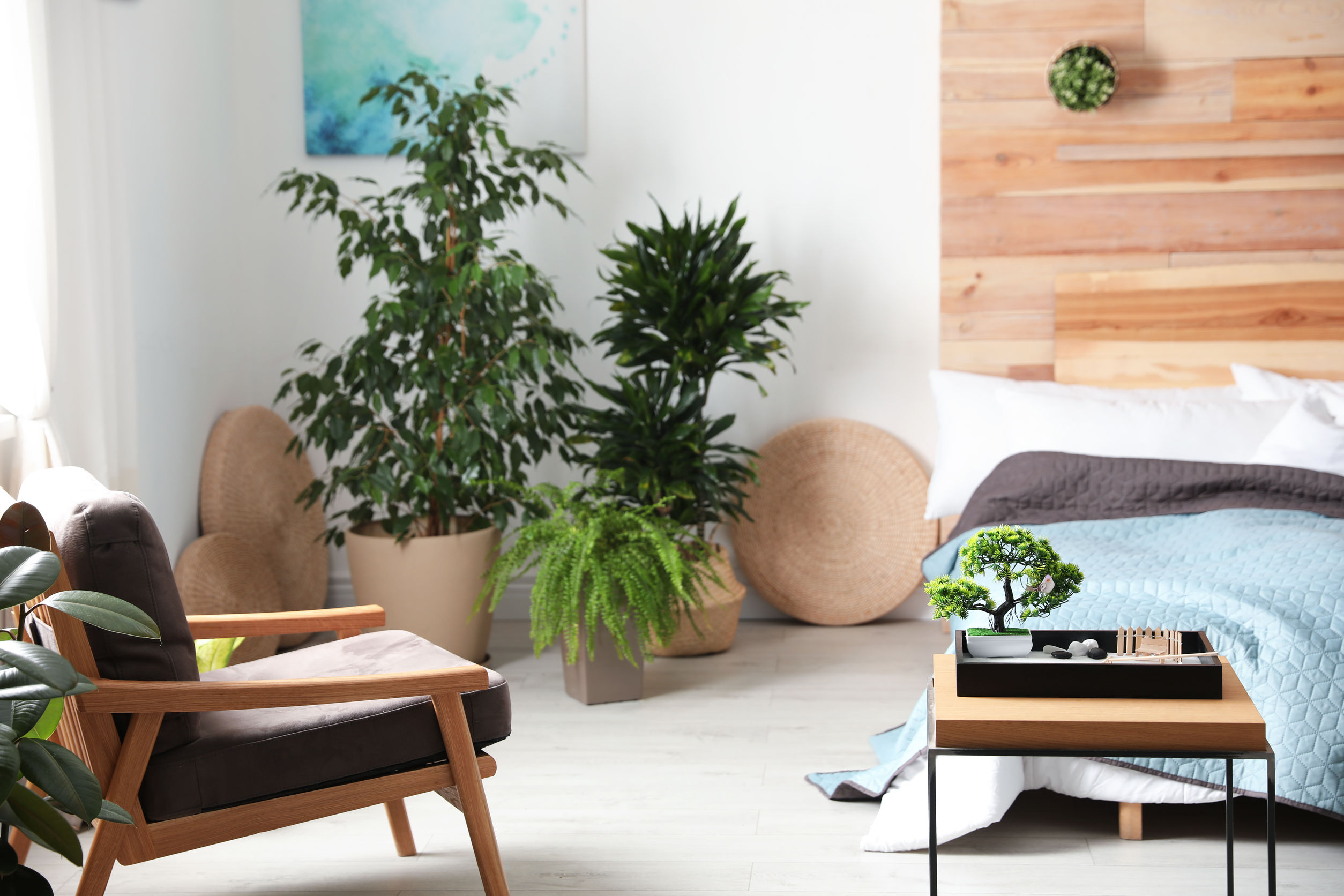”Florida, what do you do to improve your sleep? Have you taken a look at your bedroom? Our bedrooms can be optimized for sleep. This week's article makes multiple suggestions on how to maximize our sleep environments. Enjoy!
Reading Time: 10 Minutes
MWi Hacks:
- Learn multiple ways to improve your current sleep set-up
- Understand how small details like organization and symmetry can help your sleep tonight!
MWi Summary:
- The article provides several ways to improve your sleep environment. Here are a few actions you can take to help you get better sleep:
- Declutter your room
- Find your ideal pillow
- Paint your bedroom walls a soothing color
- Refrain from sleeping with pets
- Exercise regularly
- Avoid naps too close to the evening
17 Tips to Create the Ultimate Sleep Environment and Improve Your Quality of Sleep
Picture this: Despite your jam-packed schedule, you’ve still reserved enough time to unwind and relax before bed. Your bedroom is cool, calm, and dark, and you’re able to fall asleep and stay asleep without any trouble. The next morning, you manage to wake up before your alarm and feel well-rested, perhaps even energetic, and ready to take on the world. If this sounds like a scenario you can only dream of, you’re not alone –only about half of Americans wake up feeling well-rested. We’ve gathered the 17 best tips for creating the ideal sleep environment to improve your quality of sleep so you can (finally) get a good night’s rest.
1) Declutter your room
Keeping your bedroom tidy and removing any potential distractions is essential for your body to begin to relax. Important work documents, busy artwork or even a treadmill are all examples of the stressful reminders of your responsibilities that can distract you while you are trying to sleep. Instead, try to keep your room clutter-free and the décor to a minimum.
2) Reduce light exposure in the evening
For an ideal sleep environment, try room darkening window treatments, heavy curtains, or an eye mask to eliminate as much light as possible. Light can come from anywhere—streetlights, your hallway, even the moon, and stars—all of which can trick your brain into thinking it’s daytime. Blue light can also disrupt your quality of sleep. Research shows that blue light exposure keeps you awake by increasing alertness, shifting your circadian rhythm, and suppressing the sleep-promoting hormone melatonin. Set the alarm an hour before you want to lay down signaling it’s time to give up your devices, and begin your bedtime ritual or take up reading instead. You may even consider investing in filtering eyeglasses to wear throughout the day as you are looking at a computer or phone screen to avoid straining your eyes.
3) Use Essential Oils
It’s no surprise that smell influences how we feel by associating scents with emotions and memories. Often overlooked, essential oil for sleep can help you wind down, relax and eventually drift off. Essential oil aromatherapy is a quick and inexpensive solution to combat poor sleep, helping you relax physically and mentally. Lavender and vanilla are the more popular oils to help you sleep and can be added to an aromatherapy diffuser or vaporizer to disperse into the bedroom.
4) Emphasize symmetry with furniture placement
For an ideal sleep environment, it’s essential to think about the positioning of your furniture as this plays a role in the functionality and symmetry of your bedroom. For optimal balance, position your bed against the middle of a wall as far away from the door as possible, and with room on both sides. When lying in bed, you should be facing the door with your feet closest to the entrance. If possible, try to avoid lying with your head underneath the window.
5) Find your ideal pillow
To maintain spinal alignment while you sleep, the standard rule of thumb is to replace your pillow every 1 to 2 years. However, if you lie awake unable to get comfortable, or wake up with headaches, neck aches, and shoulder pains, you might consider finding a replacement earlier. When choosing pillow firmness—ranging from softer choices like down pillows to firmer choices like buckwheat pillows—keep your sleeping position in mind. Stomach sleepers tend to prefer a thin pillow, back sleepers find that medium support works best, while side sleepers favor thicker pillows. Furthermore, if you have allergies or asthma, hypoallergenic covers are an option, protecting from any allergens that may trigger your symptoms.
6) Invest in a new mattress
It’s equally important to take into consideration your sleeping position as this will determine whether a soft or firm bed is the right choice for you. Whichever mattress type you’re leaning towards—perhaps memory foam, natural fiber, or a cooling and heating mattress—be sure to test out the options in-store. Even mail-order mattress companies offer free home trials. Although most mattresses last up to 10 years, the upfront cost can indeed be intimidating. If finances are tight, foam toppers can be added to your mattress as a comfort boost and to help prevent waking up stiff and achy. Some mattresses are designed with specific health conditions in mind, so check with your doctor when selecting a new mattress if you have sleep apnea, sciatica, scoliosis, etc.
7) Consider new sheets
When shopping around for sheets, you’ll notice that there are several different thread counts, weaves and materials to choose from. These all contribute to the warmth and softness of the sheets, and choosing the ideal bed sheets depends on the type of sleeper you are. Do you wake up in the middle of the night shivering, despite the endless layers covering you? Popular choices to combat the cold are fleece and jersey, followed by silk. Or maybe you wake up feeling as though you’ve been sleeping in a sauna. If this sounds like you, consider looking into materials like cotton and linen, or maybe even bamboo bed sheets. Designed for “hot sleepers”, bed sheets with breathable fabric and temperature-regulating properties trap in less heat to help you sleep through the night.
8) Discover the perfect bedspread
Offered in many different styles—from comforters and duvet covers to blankets and throws— these top layers give extra warmth and style to your bed. Every bedspread provides a different level of weight and texture and what works for your sleep environment and comfort is entirely up to you.
9) Paint your bedroom walls a soothing color
Color has a powerful effect on our mood and can influence our sleep quality by creating a calm environment. Research shows that the best bedroom color for sleep is blue, followed by yellow, green, and silver. Try to stick to neutral, pastel, or muted shades, as bold colors can trick the brain into thinking it needs to be alert.
10) Use a sound machine/conditioner
If you have a partner that snores, live on a busy street, or catch yourself lying awake lost in your thoughts, a white noise sleep machine might be just what you’re missing. Light sleepers may prefer an app that offers a variety of nature-like noises such as crashing waves or light rainfall. Or, a simple bedroom fan could do the trick for someone uncomfortable in pure silence.
11) Select the ideal sleeping temperature
Whether you reside in Detroit, MI in the middle of winter, or Tampa, FL in the summer, the best temperature to support a healthy night’s sleep is usually between 60 and 67 degrees Fahrenheit. However, this varies from person to person, and other elements in your environment—such as climate conditions, bedding type, and pajamas—can have an influence on your best temperature for sleeping. Some people tend to be warmer sleepers than others, which could also sway their ideal sleeping temperature. Nonetheless, temperatures over 75 and below 54 degrees Fahrenheit are sure to disrupt your sleep.
12) Refrain from sleeping with pets
You may think of your pet as a member of the family, so why wouldn’t you share your bed with them? 45 percent of Americans allow their dogs in bed but that may be what is causing your restless nights. Many people have allergies to cats and dogs that can be aggravated when sharing a bed. These allergens can linger in clothes, pillows, and bedding and could cause a reaction. With a wide range of styles of pet beds and crates to consider—such as a nesting bed, elevated bed, or a heating bed—it could be time to look into an alternate sleeping arrangement for your companion.
13) Avoid caffeine consumption after 2 p.m.
We’ve all been there—it’s 10 p.m. and you are still wired from that afternoon cup of joe. Research shows that consuming caffeine even 6 hours before bed can disrupt your sleep. If you rely on a daily afternoon pick-me-up, chances are your caffeine-infused stimulant could be affecting your sleep quality and duration. Begin your day with highly caffeinated drinks and slowly reduce your caffeine intake throughout the morning by switching to tea or decaffeinated coffee. You’ll definitely want to cut out caffeine altogether by 2 p.m.
14) Exercise regularly for better sleep
Exercise not only releases endorphins but also helps you fall asleep faster and wake up feeling well-rested. Even as little as 10 minutes of exercise at any time during the day can greatly increase sleep quality. Joining a local gym, meeting regularly with a personal trainer, or finding a physical activity that you enjoy are all ways to get a good sweat in. If you have a limiting schedule, you can even create an in-home gym for flexibility and convenience.
15) Create a nighttime routine
Most activities that many of us do in the evening—such as watching TV or using our phones—can be overstimulating. By staying consistent with a calming bedtime ritual, your body will recognize that it’s time for sleep, and screen time may not be as tempting. Your nighttime routine can be as simple as brushing your teeth, washing your face, flossing and maybe even enjoying a decaffeinated bedtime tea. The options are endless, and how you begin to wind down is ultimately up to you. Dim the lights, unwind, and relax.
16) Avoid naps too close to the evening
While short power naps are encouraged and offer many benefits, long naps in the late afternoon and evening can have negative effects on your sleep quality. Instead, limit naps from 15 to 30 minutes in the early afternoon. This will increase your chances of waking up feeling rejuvenated while still being able to fall asleep easily come bedtime. Your circadian rhythm drops in the early afternoon—between 2 p.m. and 3 p.m.—and can leave you feeling more sleepy and in need of a nap. This is the best time to doze off without disrupting your sleep at night.
17) Resist snoozing the alarm
You actually wake up more tired after snoozing your alarm, especially if hitting the snooze button multiple times is part of your routine. You can’t reach the restorative level of sleep between alarms, ultimately confusing your brain and throwing off the natural wake up process. If you sleep for seven to nine hours per night, your body shouldn’t need the extra sleep and could even begin waking up on its own before your first alarm goes off. Try gradually reducing the number of times you allow yourself to snooze the alarm clock until you are waking up after just the first.
MWi would like to thank Jeff Antilla, for his expert insights that we were able to share with our community. To read the original article go to:
More on the Author:
Jeff strives to push the status quo when it comes to engagement and the user experience. In particular, he excels in B2B marketing strategies and implementation, analytics and refining processes and tactics.
Jeff currently works for Redfin as the Team Lead for Content Marketing. Here he led a team to create content-driven campaigns that engage highly targeted segments through multiple channels and outreach strategies. Jeff seeks to consistently improve SEO efforts and dominate search wherever he can.
Before Redfin, Jeff worked for Leading Retirement Solutions where he led several successful campaigns, from a national study about the retirement gap between men and women to alternative business financing stories focused on the trials and successes of business owners.
Jeff also has an MBA from Seattle University, where he developed a strong business acumen while tailoring my curriculum to focus on business analytics and marketing strategies while graduating in the top 10% of his class.






